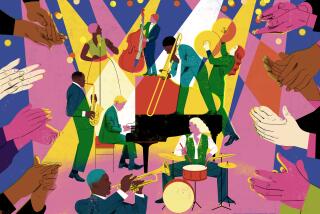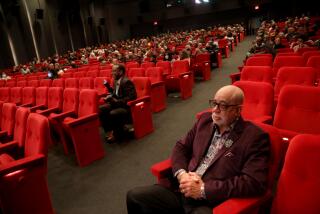Sing Your Heart Out! : Hobbies: Barbershop singing is thriving as aficionados keep up that old-time harmonizing.
- Share via
When the curtain rises on the Masters of Harmony barbershop chorus and 110 men in white tuxedos begin singing in four-part harmony, the audience is a bit stunned.
This isn’t just four old pals singing “Down By the Old Mill Stream.” This is show biz, barbershop style.
The Masters of Harmony are singing an old standard, “Let a Smile Be Your Umbrella,” but the rich voices, the complex harmony and the visual impact of 110 performing men is crowd-pleasing stuff that defies old notions about barbershop singing.
Yet the style of music known as “barbershop harmony” relies on the same unique style popularized in traveling tent shows and vaudeville acts of the 1890s through the 1920s.
That style, which featured four male singers without accompaniment, captured the fancy of the nation. Though the harmonies were precise, the form felt informal. The songs, simple in theme, were tunes about sweethearts and mothers, old times and old friends.
As the style caught on, hundreds of songs were written for the male quartets. A 1910 song called “Mister Jefferson Lord, Play That Barbershop Chord” triggered a name for the style and the quartets that sang it.
Barbershop harmony, as it has been called ever since, is characterized by four well-defined parts: the lead (second tenor) sings the melody; the first tenor sings above the melody, often in a falsetto; the baritone sings below the melody, and the bass supports the whole by singing the foundation of the chords.
The Masters of Harmony chorus represents one of 30 Southern California chapters of the Society for the Preservation and Encouragement of Barbershop Quartet Singing in America, an international society with 40,000 members, including 1,800 in Southern California.
The society was founded in 1938 when a tax attorney named O.C. Cash brought 26 men together for a barbershop songfest in Tulsa, Okla. Cash’s nostalgia for the halcyon days of barbershop harmony struck a chord among men around the country. The organization he started in Tulsa spread from coast to coast, and today enjoys membership in 800 chapters in the United States, Canada, Britain, Ireland, Sweden, Holland, Germany, Australia and New Zealand.
The Masters of Harmony chorus stands in the upper echelon of barbershop choruses. It was formed three years ago by a group of barbershoppers from several Southland chapters who had grown disaffected with what they considered was a casual approach to singing. They sought to create a chorus with musical standards that could compete with the world’s top choruses in the society’s annual competition.
The fortuitous arrival of Greg Lyne in Southern California solidified the new chapter’s aim. Lyne had directed the Westown Chorus of Chicago to an international championship. After moving west in 1987 to become director of choral studies at California State University at Long Beach, Lyne took the helm of the Masters of Harmony.
The opportunity to sing with other serious, highly motivated barbershoppers--and with one of the top directors in the country--has attracted more than 100 men to the new Foothill Cities Chapter chorus. Members travel to weekly rehearsals in Santa Fe Springs from as far away as San Diego and Oxnard. Their occupations range from surgeon to student, and their ages from 19 to 72.
Last summer, the Masters of Harmony made their mark on the world of barbershopping by placing first in the Far Western District of the society, and fourth in international competition.
“It’s very unusual group of singers,” says Lyne. “They’re very motivated, very quick to learn.”
For most barbershoppers, singing is a hobby and weekly chapter rehearsals are times of fellowship. The attitude is “y’all come, so long as y’all can carry a tune.” Members of the Masters of Harmony, though, are clearly more than hobbyists. Prospective harmonizers audition and interview to demonstrate not only an ability to sing, but a commitment to the chapter’s goal--to be the best chorus in the world.
“No one wants to be the weak link in the chain,” says Masters of Harmony member Ken Custer of Azusa. “We’re not better singers than any other chorus, but we’re very dedicated. We learn our music quickly. One of our goals is to be the best men’s singing organization in the world--not just in barbershop. We want to be recognized as peers and equals to any other group out there performing.”
A Masters of Harmony rehearsals--open to visitors--is a demonstration of the camaraderie and fellowship that is common to all barbershoppers, but with a seriousness of purpose that resembles a philharmonic orchestra rehearsal.
The tall, agile, silver-haired Lyne strides back and forth in front of the risers (the chorus stands for the entire three-hour rehearsal) correcting fine points of harmony, singing a phrase for the tenors, working on a baritone part that sounds flat on one chord.
Lyne twirls an index finger and, instantly, 110 men imitate him. “It’s to keep the rhythm going,” Lyne explains later. Lyne puts both hands to his ears and 110 men respond. “It’s to concentrate on a difficult harmony; it’s difficult to hear yourself otherwise.”
The tune being rehearsed is “Mississippi Mud,” a difficult but sure-fire showstopper from 1927. The chorus will perform the upbeat song in international competition in July in San Francisco, having already won the Far Western District competition a second consecutive year.
During a break, the Masters of Harmony are masters of joviality. Impromptu quartets form, either to “woodshed” a song, or simply for the joy of harmonizing. One quartet drags in a visitor as an ersatz baritone. Learning a four-bar tag proves surprisingly easy--and decidedly thrilling.
“That’s how we get people hooked on barbershopping,” says Ken Custer.
What makes barbershop singing such a compelling pastime, and so delightful to hear?
A musicologist might explain it in terms of the tight harmonies, featuring chords with a dominant seventh that create surprising overtones and undertones. Nostalgia buffs simply love the old songs, with their simple melodies and understandable lyrics--though barbershop songs are constantly being written. Masters of Harmony cite the thrill of competition, and the joy that comes from bowling over an audience.
Choreography is another hallmark of a top-flight barbershop chorus or quartet. According to Lyne, there’s not a dancer in this bunch, but the singers quickly pick up some motions for “Mississippi Mud.” By the end of this special all-day Saturday rehearsal, the chorus has the music down cold; the steps are memorized and ready to polish. Even in casual garb, the effect is dazzling.
“We gang up on an audience,” says chorus member Mike Trilling. “We want them to be as tired as we are after a performance.”
The Southland’s top barbershop foursome, the 139th Street Quartet, has had even wider exposure than the Masters of Harmony.
The quartet has twice appeared on television’s “Cheers,” once on “Night Court” and in the Mark Taper Forum production of “Babbitt.” They have sung in all but six or seven states, and in England. (Top quartets are in perennial demand as guest performers at annual chapter shows around the country.)
Though 139th Street competes in the upper tier of quartets--they finished third in last year’s international competition--baritone Pete Neushel of Palos Verdes says his quartet’s emphasis is on fun.
“We’re unusual (among top quartets) in that we do this just for fun,” he says. “It’s a tension reliever, a creative outlet, like exercise. Personally, it’s what keeps me sane. No matter how rotten your day is, if you go off and sing, you just can’t feel bad. Singing always makes you feel better.”
The 139th Street Quartet is not a comedy quartet per se, but Neushel admits to being “pretty silly. We take how we sing seriously, but it’s hard to sing ‘Sally, Pure as Driven Snow’ with a straight face.”
Neushel also is spearheading an coming U.S. tour of the only barbershop quartet in the Soviet Union. Two years ago, a group of Soviet musicians heard a German group perform (“They flipped out,” according to Neushel), obtained musical arrangements from the Germans, and have been singing barbershop harmony together ever since. The Soviet chorus will perform in Los Angeles in late June and at the Society for the Preservation and Encouragement of Barbershop Quartet Singing in America’s international convention in San Francisco in early July.
For Southland society chapters, February through May is “show season.” A typical show features the chapter chorus, quartets from within the chorus, and, often, a guest quartet. After the show, an informal “afterglow” provides a chance to hear more singing, to sing along, and to meet the performers.
Barbershop fans can attend a chapter show nearly every weekend somewhere between San Luis Obispo and San Diego. For information:
* Far Western District Barbershop Office can provide show times and places, and refer men interested in barbershop singing to a nearby chapter. Choruses welcome visitors to rehearsals, and most chapters are more casual and less demanding than the Masters of Harmony. Call (818) 369-8788.
* The Sweet Adelines is a society for women who enjoy barbershop singing. Call (818) 349-1406.


